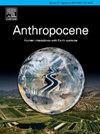巢湖流域166年来人类活动的沉积物磁记录
IF 3.3
2区 地球科学
Q2 ENVIRONMENTAL SCIENCES
引用次数: 0
摘要
湖泊系统沉积物磁性特征的变化一般归因于各自流域的人类活动;然而,沉积物磁性指标与人类活动类型或强度之间的关系尚不明确,这限制了磁性指标在古环境重建中的应用。本文通过对安徽巢湖沉积物岩心的测年测量,探讨了环境磁学指标是否以及在多大程度上反映了过去166年来巢湖盆地复杂的人类活动。结果表明,碎屑磁铁矿矿物是沉积物中主要的磁铁矿组分。1950年前后沉积物的磁性浓度指标(χ f、χARM和SIRM)最小,表明碎屑磁性矿物的输入最小,表明流域受到的干扰有限,这与该时期湖盆的人类活动较弱(主要是原始农业活动)相吻合。在大约1950-1985年沉积的沉积物中,与粒度相关的指标(χfd%, SIRM/χ f %和χARM/χ f %)的增加和减少表明碎屑磁性矿物的输入增加和磁性颗粒的粗化。这种变化可能是由于20世纪50年代以来湖泊集水区农业和工业活动的快速发展,以及60年代大坝建设导致湖泊内水动力减弱的结果。1985年以后,χ f、χARM和SIRM逐渐下降到1950年以前的水平,表明磁性矿物输入进一步减少。这可能是由于城市化扩张和从高污染工厂转向高科技工业导致农业活动减少。总体而言,沉积物岩心的磁代用物轨迹反映了湖盆人类活动类型和强度的历史变化。该研究为利用环境磁指标进行古环境重建提供了重要依据。本文章由计算机程序翻译,如有差异,请以英文原文为准。
Sediment magnetic records of human activities in Lake Chaohu Basin over the past 166 years
Variations of sediment magnetism characteristics in lake systems are generally attributed to human activities in the respective catchments; however, the relationships between sediment magnetism proxies and the types or intensities of human activities are generally poorly established, which restricts the use of magnetism proxies in paleoenvironmental reconstructions. Here, magnetic parameters were measured in a dated sediment core from Lake Chaohu, Anhui Province, China, to explore whether and to what extent environmental magnetism proxies indicate the complex human activities in the lake basin over the past 166 years. Results demonstrate that detrital magnetite minerals were the major magnetite fraction in the sediments. The lowest values of magnetic concentration proxies (χlf, χARM, and SIRM) in sediments prior to approximately 1950 indicate minimal input of detrital magnetic minerals, implying limited disturbance of the catchment, which coincided with weak human activities in the lake basin in this period—mainly primitive agriculture. In sediments deposited during ca. 1950–1985, increased χlf and reduced grain size-dependent proxies (χfd%, SIRM/χlf, and χARM/χlf) indicate increased input of detrital magnetic minerals and coarsening of the magnetic grains. This shift might have resulted from the rapid development of agricultural and industrial activities in the lake catchment since the 1950s and decreased hydrodynamic force within the lake due to dam construction in the 1960s. After ca. 1985, χlf, χARM, and SIRM gradually decrease to the pre-1950 levels, indicating further decrease of the magnetic mineral input. This is likely due to decreased agricultural activities as a consequence of urbanization expansion and a shift from high pollution factories to high-tech industry. Overall, the trajectories of magnetic proxies in the sediment core reflect historical variations of the types and intensities of human activities in the lake basin. This study constitutes an important basis for the use of environmental magnetic proxies in paleoenvironmental reconstructions.
求助全文
通过发布文献求助,成功后即可免费获取论文全文。
去求助
来源期刊

Anthropocene
Earth and Planetary Sciences-Earth and Planetary Sciences (miscellaneous)
CiteScore
6.30
自引率
0.00%
发文量
27
审稿时长
102 days
期刊介绍:
Anthropocene is an interdisciplinary journal that publishes peer-reviewed works addressing the nature, scale, and extent of interactions that people have with Earth processes and systems. The scope of the journal includes the significance of human activities in altering Earth’s landscapes, oceans, the atmosphere, cryosphere, and ecosystems over a range of time and space scales - from global phenomena over geologic eras to single isolated events - including the linkages, couplings, and feedbacks among physical, chemical, and biological components of Earth systems. The journal also addresses how such alterations can have profound effects on, and implications for, human society. As the scale and pace of human interactions with Earth systems have intensified in recent decades, understanding human-induced alterations in the past and present is critical to our ability to anticipate, mitigate, and adapt to changes in the future. The journal aims to provide a venue to focus research findings, discussions, and debates toward advancing predictive understanding of human interactions with Earth systems - one of the grand challenges of our time.
 求助内容:
求助内容: 应助结果提醒方式:
应助结果提醒方式:


